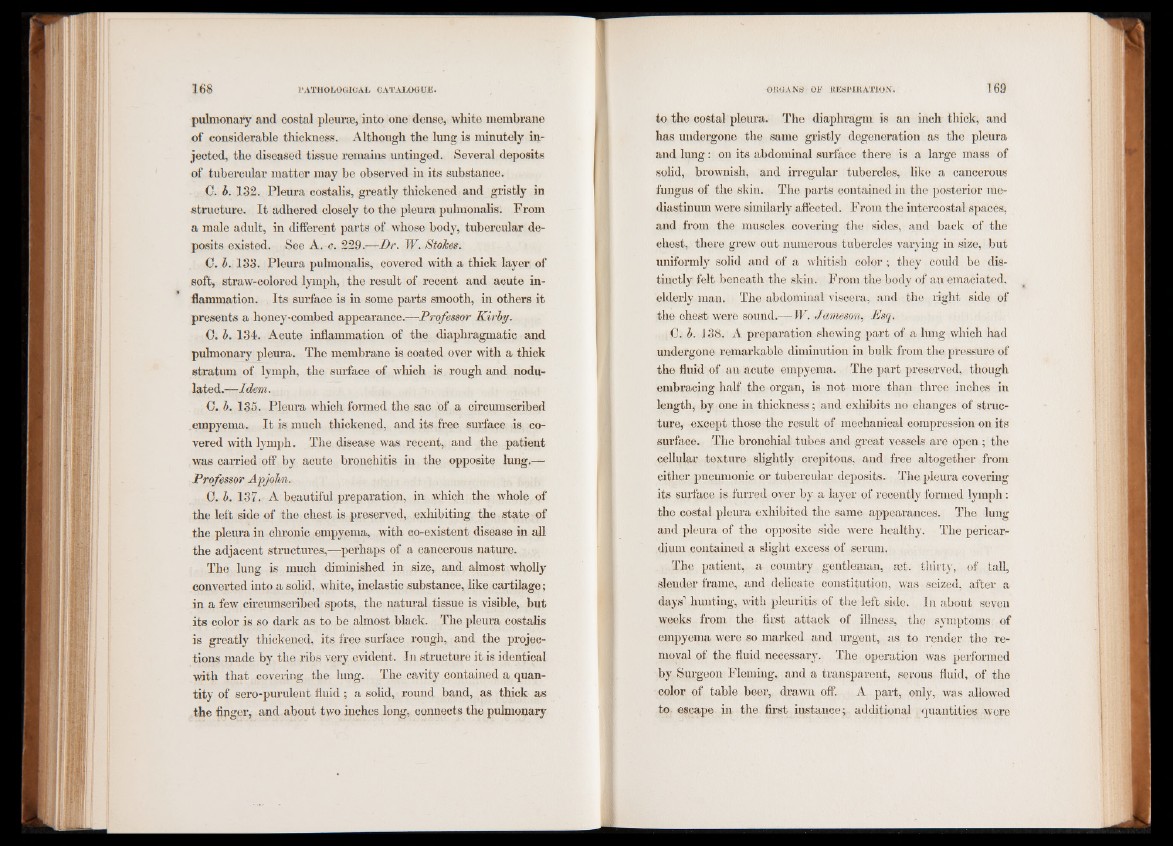
pulmonary and costal pleurae, into one dense, white membrane
of considerable thickness. Although the lung is minutely injected,
the diseased tissue remains untinged. Several deposits
of tubercular matter may be observed in its substance.
C. b. 13 2 . Pleura costalis, greatly thickened and gristly in
structure. It adhered closely to the pleura pulmonalis. From
a male adult, in different parts of whose body, tubercular deposits
existed. See A. c. 229.—Dr. W. Stokes.
C. b. 133. Pleura pulmonalis, covered with a thick layer of
soft, straw-colored lymph, the result of recent and acute inflammation.
Its surface is in some parts smooth, in others it
presents a honey-combed appearance.:—Professor Kirby.
C. b. 134. Acute inflammation of the diaphragmatic and
pulmonary pleura. The membrane is coated over with a thick
stratum of lymph, the surface of which is rough and nodulated.—
Idem.
C. b. 135. Pleura which formed the sac of a circumscribed
empyema. It is much thickened, and its free surface is covered
with lymph. The disease was recent, and the patient
was carried off by acute bronchitis in the opposite lung.—
Professor Apjolm.
0. b. 137. A beautiful preparation, in which the whole of
the left side of the chest is preserved, exhibiting the state of
the pleura in chronic empyema, with co-existent disease in all
the adjacent structures,—perhaps of a cancerous nature.
The lung is much diminished in size, and almost wholly
converted into a solid, white, inelastic substance, like cartilage;
in a few circumscribed spots, the natural tissue is visible, but
its color is so dark as to be almost black. The pleura costalis
is greatly thickened, its free surface rough, and the projections
made by the ribs very evident. In structure it is identical
with that covering the lung. The cavity contained a quantity
of sero-purulent fluid; a solid, round band, as thick as
the finger, and about two inches long, connects the pulmonary
to the costal pleura. The diaphragm is an inch thick, and
has undergone the same gristly degeneration as the pleura
and lung: on its abdominal surface there is a large mass of
solid, brownish, and irregular tubercles, like a cancerous
fungus of the skin. The parts contained in the posterior mediastinum
were similarly affected. From the intercostal spaces,
and from the muscles covering the sides, and back of the
chest, there grew out numerous tubercles varying in size, but
uniformly solid and of a whitish color ; they could be distinctly
felt beneath the skin. From the body of an emaciated,
elderly man. The abdominal viscera, and the right side of
the chest were sound.-—IF. Jameson, Esq.
... 0. b. J38. A preparation shewing part of a lung which had
undergone remarkable diminution in bulk from the pressure of
the fluid of an acute empyema. The part preserved, though
embracing half the organ, is not more than three inches in
length, by one in thickness; and exhibits no changes of structure,
except those the result of mechanical compression on its
surface. The bronchial tubes and great vessels are open ; the
cellular texture slightly crepitous, and free altogether from
either pneumonic or tubercular deposits. The pleura covering
its surface is furred over by a layer of recently formed lymph :
the costal pleura exhibited the same appearances. The lung
and pleura of the opposite side were healthy. The pericardium
contained a slight excess of serum.
The patient, a country gentleman, set. thirty, of tall,
slender frame, and delicate constitution, was seized, after a
days’ hunting, with pleuritis of the left side. In about seven
weeks from the first attack of illness, the svmptoms of
empyema were so marked and urgent, as to render the removal
of the fluid necessary. The operation was performed
by Surgeon Fleming, and a transparent, serous fluid, of the
color of table beer, drawn off. A part, only, was allowed
to escape in the first instance; additional quantities were